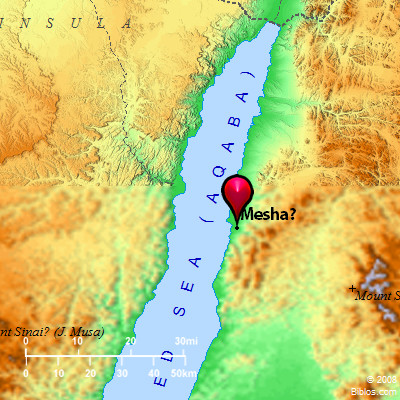Encyclopedia
MESHAme'-sha:
(1) (mesha`; Codex Vaticanus, Marisa; Codex Alexandrinus, Marisas): Caleb's firstborn son, the father of Ziph, probably the ancestor of the Ziphites (1 Chronicles 2:42).
(2) (mesha'; Codex Vaticanus, Misa; Codex Alexandrinus, Mosa): A Benjamite, son of Shaharaim by his wife Hodesh, born in the land of Moab (1 Chronicles 8:9).
(3) (mesha`; Mosa): A king of Moab. All the Biblical information regarding this monarch is contained in 2 Kings 3. Here we gather that Mesha was contemporary with Ahab, Ahaziah and Jehoram. He was tributary to Israel, his annual contribution consisting of 100,000 lambs and 100,000 rams. after the death of Ahab he asserted his independence. Jehoshaphat, king of Judah, and the king of Edom joined forces with Jehoram in an attempt to quell the rebellion at the instance of Elisha, who accompanied the host, water was miraculously provided when the army of the allies was ready to perish of thirst. Mesha came out against them and fell upon the camp. His attack was repulsed with heavy slaughter, and the defeated king was chased by the victors until he took refuge in the great fortress of Kir-hareseth. A vigorous siege was begun. See ing that his case was desperate, Mesha attempted, with 700 men, to break through the lines. Failing in this, he offered his firstborn as a burnt offering upon the wall. Then "there came great wrath upon Israel" (by which, probably, panic is meant), and the besiegers retired, leaving their conquest incomplete.
In his inscription (see MOABITE STONE) Mesha gives an account of his rebellion, naming the places captured and fortified by him. It is not surprising that he says nothing of his defeat by Jehoram and his allies. There is, however, one serious discrepancy. The time Moab was under the supremacy of Israel, during the reign of Omri and half the reign of Ahab, he puts at 40 years. According to Biblical chronology, Omri and Ahab together reigned only 34 years. If, with Mesha, we deduct half the reign of Ahab, the period is reduced to 23 years. It is impossible to add to the length of either reign. So great a difference cannot be explained by the use of round numbers. Why Mesha should wish to increase the time of his people's subjection is not clear, unless, indeed, he thought in this way to magnify the glory of their deliverer.
In Mesha the sentiment of patriotism was wedded to some measure of military capacity. Judging by his inscription, he was also a deeply religious man according to his lights. Substitute "Yahweh" for "Chemosh," and his phraseology might be that of a pious Hebrew king. The sacrifice of his son is at once the mark of the heathen and an index of the strength of his devotion.
(4) (mesha'; Masse): This appears to mark the western boundary of the land occupied by the descendants of Joktan (Genesis 10:30). No certain identification is possible, but several more or less probable have been suggested: e.g.
(a) The Greek Mesene, on the Persian Gulf, not far from the mouth of the Tigris and the Euphrates;
(b) the Syro-Arabian desert, called Mashu in the Assyrian inscriptions; the name here, however, could hardly cover such a vast tract as this; more probably it denoted a place;
(c) Dillmann would alter the vowels and identify it with Massa', a branch of the Ishmaelite stock (Genesis 25:14 1 Chronicles 1:30). This, however, furnishes no clue to the locality, the territory of that tribe being also unidentified.
W. Ewing




